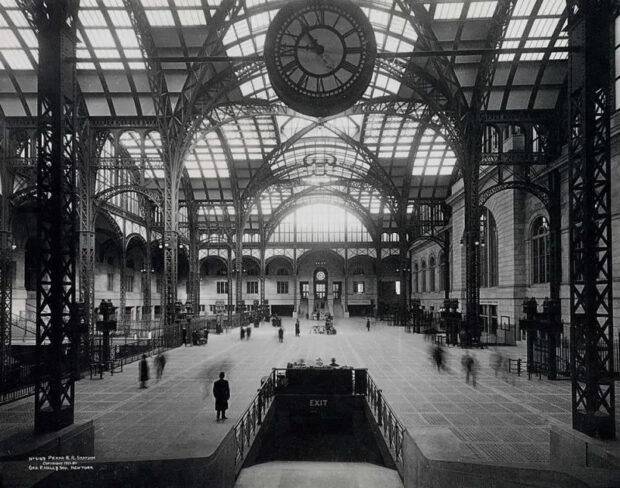On the eve of Thanksgiving Day, the National Society of Civil Art of the United States launched an advertising campaign in New York City to raise funds for the restoration of the original Pennsylvania Station. The legendary Penn Station demolition that they called the 1963 demolition «the greatest architectural crime of the 20th century».
More recently, passengers arriving at modern Penn Station were greeted with posters with archived photos and visualization of the renovation project. Moreover, the streets of Long Island were filled with flyers from the planes, urging citizens to donate to the reconstruction of the station. The rally was held under the motto «Station we deserve».

Archival photos allow you to estimate the size of the Penn Station.
The majestic building in the beaux-arts style was built in 1905-1910 by order of the Pennsylvania Railroad and was considered the main attraction of Manhattan.
See also The Best Restaurants in the Meatpacking District: Add this to Your List
The architect Charles McKim, who then headed McKim, Mead & White, was inspired by the Roman Baths of Caracalla and created a huge palace complex, where the walls of the station’s main hall were decorated with pink granite and travertine. Ceilings were decorated with exquisite caissons, and the facade was decorated with 84 order columns.

Columns with Corinthian capitals and coffered ceilings – a direct allusion to the Roman baths.
The steel frames and delicate arcades above the platforms reminded us of Gare d’Orsay in Paris. And the main building of Penn Station with its grandeur is the imperial architecture of Rome. Penn Station was so large that the residents joked that the Grand Central Terminal would easily fit in its foyer.

The space above the platforms in 1911. Light from underneath the transparent dome fell down to the landing platforms through laminated glass skylights.
And in 1963, the station was demolished, despite the protests of New Yorkers, and for most Americans, it was completely unexpected. The Pennsylvania Railroad was on the verge of bankruptcy and decided to get rid of the disproportionately large station and lease the vacated space.

1962 year. New Yorkers are demonstrating to demand that Penn Station be retained.
“The one who entered the city like a god now sneaks in like a rat.”
On the site of Penn Station, an office center and a cylindrical bowl were built at Madison Square Garden, which hosts the matches of the National Hockey League and the National Basketball Association. The transport hub itself turned out to be tightly “sealed” underground and lost natural light.
The demolition of Penn Station is still considered the most outrageous act of vandalism against architectural monuments in America. After a scandal that caused the destruction of Penn Station, the mayor of New York was forced to create a commission for the protection of architectural heritage.
Emphasizing the difference between the former gateway to New York and what the station looked like now, architecture critic Vincent Scully stated, “Whoever entered the city like a god now sneaks in like a rat.” This phrase has become a catchphrase because it very accurately conveys the feelings of passengers from the cramped, dark, and stupidly organized space of the Penn Station.
See also Atlas Obscura: How to Immerse Yourself in the History of Your Homeland
The fact that Penn Station in its current form does not meet modern requirements and the status of a metropolis is also recognized by the local authorities. New York State Governor Andrew Cuomo said the transport hub and station would certainly have to be upgraded.

Such a reconstruction project was proposed by the architect Vishaan Chakrabarti – while maintaining the cylindrical structure of Madison Square Garden.
Architect Vishaan Chakrabarti, the founder of the New York firm Architecture & Urbanism, proposed relocating Madison Square Garden. In the old place, on the basis of the same cylindrical structure, erect a transparent pavilion with double glazing, the ceiling of which would be decorated with a giant map of New York. It is impossible to significantly change the structure of railway tracks and platforms due to the features of the relief, however, such a modernization option would free up space from the pressing ceilings and supports that impede the movement of passengers.
The antagonist of the Chakrabarti project is Richard Cameron, the chief designer at Atelier & Co. Since the 1990s, he has sought to restore the Penn Station to its original form, based on sketches by Charles McKim.

“The station we deserve.” A sketch of an advertising campaign to raise funds for the restoration of Penn Station.
As precedents for a large-scale reconstruction of destroyed historical buildings, Cameron cites examples of the post-war reconstruction of Dresden, Warsaw, and of the latter – the rebuilding of the Berlin Palace – Berliner Stadtschloss. Recall that in 2006 in East Berlin, the Palace of the Republic was demolished, which stood on the ruins of the Berliner Stadtschloss.
It is Cameron’s idea that the National Society for Civil Art is promoting. The activists are not even embarrassed by the figure of $ 7.5 billion – this is how the budget for the transfer of the stadium to a new location, the modernization of transport routes, and the construction of the main station building was tentatively estimated. They argue that a masterpiece of the early 20th century can be perfectly replicated since more than three hundred original sketches and plans have been preserved in the archives.
Such a large-scale renovation has certainly affected the area around Penn Station. However, Cameron and his supporters are confident that the return of the gates of New York to their historical appearance will positively affect the value of the real estate in the district and will attract tourists and investors.
Like us on Facebook for more stories like this: